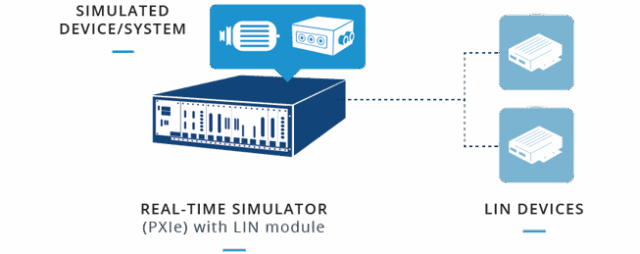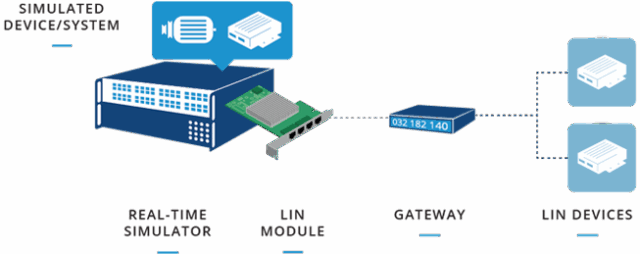LIN
Our LIN protocol solution is available on both NI and RT-LAB platforms. For the RT-LAB platform, a gateway device is required to link a LIN device to a CAN port on an OPAL-RT simulator. This gateway converts LIN messages into CAN messages and vice versa, enabling the OPAL-RT real-time simulator to communicate with a LIN device in various setups, such as RCP or HIL.
Learn more about LIN
LIN is a protocol with one master device and one or more slaves, where the master sends all messages, and only one slave responds to each message identifier. Because the master initiates communication, a timing schedule is set in the bus description, removing the need for collision detection. Known for its cost-effectiveness, LIN is widely used in the automotive industry for communication between car components.
We recommend the IXXAT FRC-EP 170 or 190 Gateways, which support bidirectional protocol conversion using IXXAT’s ACT Software. Users can upload their LIN Description File (LDF) to the IXXAT device, which converts it into a CAN DBC file, allowing for a unified description of the communication bus architecture across both protocols.
On the NI PXI platform, support is provided through a range of compatible cards and modules, covering LIN versions 1.3, 2.0, and 2.1. Using the NI-XNET driver, users can establish real-time communication with external LIN devices. The LIN bus architecture, along with the timing schedule of messages, can be customized in VeriStand.
Platform compatibility
RESOURCES
Product guide
Explore our communication protocols, browse product lists, and access user documentation.

FAQ
Find the answers to your questions
What Is the LIN Protocol and How Is It Used in Real-Time Simulation?
The LIN protocol (Local Interconnect Network) is a cost-effective, single-master/multi-slave communication protocol widely used in automotive applications. We support the LIN communication protocol through both RT-LAB and NI platforms for use in Hardware-in-the-Loop (HIL) and Rapid Control Prototyping (RCP) simulations.
How Does OPAL-RT Enable CAN and LIN Protocol Integration?
We support CAN and LIN protocol integration by using a gateway device that converts LIN messages into CAN messages and vice versa. This allows seamless communication between LIN devices and our real-time simulators through the CAN interface.
What Are the Key Applications of the LIN Automotive Protocol in OPAL-RT Systems?
The LIN automotive protocol is primarily used to test and simulate communication between vehicle components such as ECUs and sensors. Our platforms allow engineers to validate these systems in real-time using HIL and RCP configurations.
How Is the LIN Interface Protocol Implemented on OPAL-RT’s Platforms?
On RT-LAB, the LIN interface protocol is supported via a gateway that links LIN to a CAN port. On NI PXI platforms, the LIN bus is managed through NI-XNET drivers and compatible hardware, enabling real-time testing and control using VeriStand.
What Role Does the LIN Description File (LDF) Play in OPAL-RT Simulations?
The LIN description file (LDF) defines the timing and message structure of the LIN bus. Our solution allows users to upload the LDF to the IXXAT gateway, which converts it to a CAN DBC file—streamlining configuration across both LIN and CAN systems.


